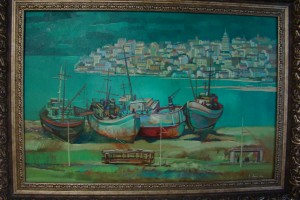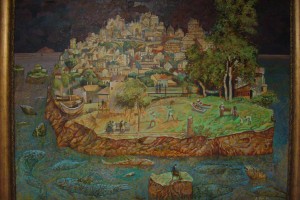 ALMATY – The cultural life of the city has been enhanced by the opening of a new gallery at the Gazeeff Art Hall. The exhibition displays the work of Kazakh artist Vyacheslav Lyui-Ko.
ALMATY – The cultural life of the city has been enhanced by the opening of a new gallery at the Gazeeff Art Hall. The exhibition displays the work of Kazakh artist Vyacheslav Lyui-Ko.
Slightly dimmed light and the soft reflection of mirror-polished slabs and the contrasting lights and shadows give a clear one-on-one feeling with the thoughts and passions of the artist. Visitors sit on a sterile white sofa and immerse themselves in contemplation.
It is symbolic that the organisers called the first exhibition “The Island.”The gallery causes creative energies to boil. Art critic Tatyana Martysheva said that the art exhibit is anon-profit project that puts on literary evenings holds lecture series and themed exhibitions for outstanding artists from Kazakhstan and that it presents albums, catalogues, calendars, as well as poetry books.
The gallery’s unique collection consists of paintings and drawings of Kazakh fine art from the19th and 20th centuries. It is intended not only to pique the senses, but also to teach the viewer to distinguish professional art from surrogate works and promote the cultural life of the city. Visitors will see the creative works of the founders of the Kazakh visual arts: Aubakir Ismailov and Sergey Kalmikov, our contemporaries: Yevgeny Sidorkin, Gulfairus Ismailova, Aisha Galimbayeva, Zhanatay Shardenov, Kenzhebay Duissenbayev, Saken Bektiyarov, Nicholay Gazeyeva and Gani Bayanov.
The collection of paintings and drawings was gathered by famous collector, Serik Ustabekov. He also writes poetry for Lyui-Ko’s illustrations. The collector chooses paintings based on creative intuition and preferences. This is seen in the current retrospective exhibition.
Landscape and fantastic abstract compositions, unprecedented journeys, ritual dances and knightly battles, portraits of sailors and fishermen – all of these represent the artist’s various perceptions of the world. You will not see banal themes and subjects here and the audience is invited to co-create and participate in the event. Conveniently sitting on the white sofa, waiting for guests, the author told about the secret subtext of the Island.
“You can connect everything here: independently collected art and the person who owns it. I would describe the exhibition as a small excursion into the past. Many things were written in the last century before other things were stored in personal collections,” he said.
“I cannot create impressionist works with complex colours, I am far from being an impressionist,” he added.
What is the exhibition? Is it a tribute to fashion?
Not at all. Otherwise, I would be engaged in contemporary art, but I’m conservative. Contemporary artists do installations and stuff like that. Let them do that. Classical artists are raised on different values and they do not defy them.
Are you by nature an open person?
I am in a narrow circle. I’m like everyone, something is always missing. Trips help me pass the time and inspire my paintings.
What is the incentive behind life and creativity?
Creativity is a way of life. It is most important that one’s family life is good. My audience consists of intellectuals, readers, the inquisitive and those interested in something more than just making money. At Abay Kazakh Pedagogic Institute, where I studied, I met people enthusiastic about their craft. I “entered the stream” and worked hard. I cannot stop. We were mainly self-educated and I consider those who introduced me to classical paintings to be my teachers. I read lots of books and saw many works. The Renaissance is close to me – especially the Flemish and German contributions. Still, I’m still discovering immutable truths, portraying them as symbols and images on canvas. The story behind a painting is hidden. It is not about impressionism, nor about the fact that it only captures one fleeting moment in time. You know the Bible’s Tower of Babel, to make assumptions is the right of every viewer and is an almost never-ending process.
What is your island?
My island is what the viewer sees in my pictures. My island broke off from the rest of the world and if to exclude television, includes my city, my family, friends, house and where we spend time together frying kebabs. Life is dear to everyone.


